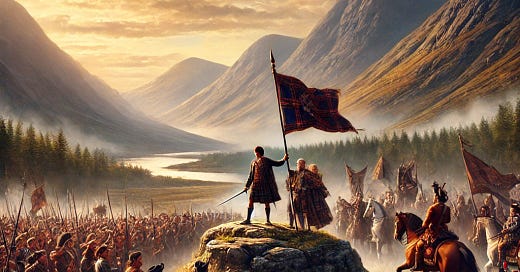The Gathering at Glenfinnan: The Prelude to the Jacobite Uprising
On the 5th of July, 1745, Prince Charles Edward Stuart embarked on a bold and romantic journey from Belleisle, France, with a small group of zealous Jacobites. Sailing in a modest frigate armed with 16 guns, they arrived at the Outer Hebrides on the 23rd of July. For two days, Charles remained on board, sending letters to his supporters, receiving replies, and consulting with allies about the best methods to rally the clans loyal to his cause. By July 25, all arms, ammunition, and supplies had been unloaded, and preliminary preparations were made for Charles's landing.
A Strategic Landing at Borodale
Charles chose to land at Borodale, a farm in Arisaig, Inverness-shire, owned by Clanranald. Angus Macdonald, the tenant, warmly welcomed Charles and his suite. About one hundred clansmen, gathered by two Macdonalds at Clanranald's request, served as a bodyguard for the Prince. This location, remote and difficult to access, was surrounded by loyal descendants of Kilsyth and Killicrankie heroes, making it an ideal refuge. These mountaineers, still nursing a desire for revenge due to the cruelties following the 1715 insurrection and the disarming act's affronts, saw an opportunity for retaliation.
When news of Charles's landing spread, the entire neighborhood, regardless of age or sex, flocked to Borodale to see the man whose success they believed would bring glory and happiness to their country. Eager to meet his warm-hearted visitors, Charles seated himself prominently in a room where a meal was prepared, sharing the fare cheerfully and banishing thoughts of past or future troubles.
Securing Support from the Clans
Charles sent fresh messengers to all chiefs expected to support him, requiring their presence. Macdonald of Keppoch, believing in duty to protect the Prince despite the risk, advocated raising men immediately. Macdonald, younger of Scothouse, persuaded Lochiel to visit Borodale, though Lochiel was initially determined not to take up arms. Despite his brother's warnings, Lochiel met Charles, intending to refuse support. Charles candidly shared his grievances against the French ministry and admitted his meager resources, seeking to convince Lochiel of the opportune moment.
Lochiel argued that without foreign support, they were freed from their obligations. Charles maintained that an advantage over government forces would rally the country and prompt foreign aid. Lochiel's resistance crumbled under Charles's determination to proceed regardless of support, leading Lochiel to declare his loyalty, saying, "I'll share the fate of my Prince."
With Lochiel's support secured, Charles planned to raise his standard at Glenfinnan on August 19. He dispatched letters to the chiefs and returned to Kinlochmoidart, where Highlanders armed enthusiastically. Fort William, threatened by Lochiel and Keppoch's assembly, received reinforcements from Fort Augustus. However, these reinforcements were captured by Lochiel's men, marking the start of hostilities. This capture, celebrated by the Highlanders, spurred their commitment to the cause.
The Gathering at Glenfinnan
Charles departed Kinlochmoidart on August 18, traveling to Glenalladale and joined by Gordon of Glenbucket. On August 19, Charles and his party landed at Glenfinnan, greeted by Morar and 150 men. Initially disappointed by the lack of clans, Charles's spirits lifted when Lochiel and 700-800 Camerons arrived. Without delay, the Marquis of Tullibardine unfurled the Jacobite standard, proclaiming the Chevalier de St. George as king. Keppoch joined with 300 men, and the glen, once lonely, now bustled with about 1,200 loyal Highlanders.
The raising of the standard marked the beginning of the tragic 1745 Jacobite uprising. Though ultimately unsuccessful, this event brought ruin to many noble families and misery to the Highland population. A monument erected by Alexander M'Donald of Glenalladale at the spot commemorates those who fought and bled in the rebellion. The English inscription reads:
"On this spot where Prince Charles Edward first raised his standard, on the 19th day of August, 1745, when he made the daring and romantic attempt to recover a throne lost by the imprudence of his ancestors, this column is erected by Alexander M'Donald, Esq. of Glenalladale, to commemorate the generous zeal, the undaunted bravery, and the inviolable fidelity of his forefathers, and the rest of those who fought and bled in that arduous and unfortunate enterprise. This pillar is now, alas! also become the monument of its amiable and accomplished founder, who, before it was finished, died in Edinburgh on the 4th January, 1815, at the early age of 28 years."
The Unfolding Drama
The events leading to the raising of the standard at Glenfinnan were marked by strategic planning, fervent loyalty, and an unwavering determination. Charles's journey from France, his landing at Borodale, and the support he garnered from the Highland clans set the stage for one of the most dramatic episodes in Scottish history. The Jacobite standard raised at Glenfinnan symbolized a bold attempt to reclaim a lost throne, embodying the hopes and dreams of those loyal to the Stuart cause.
The gathering at Glenfinnan and the raising of the Jacobite standard was a pivotal moment in Scottish history, symbolizing the enduring spirit and loyalty of the Highland clans to the Stuart cause. This act not only marked the beginning of the 1745 uprising but also highlighted the complexities and passionate loyalties that defined this period. The monument at Glenfinnan stands as a testament to the bravery and sacrifice of those who rallied to Charles Edward Stuart's call, forever etching their names in the annals of history.





